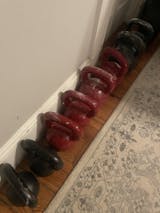
Why should you listen to me discuss being a great coach, since I’m the one in the hospital? Well, this wasn’t a case of getting injured while reaching for a pencil or during an out of control max deadlift attempt. Rather, this was a very bad injury that occurred 24 years ago. In reality, holding off a serious injury for 24 years can be seen as evidence of doing something right.
Asking the Right Questions
I’ll be the first to say that I haven’t always done everything correctly, and that’s also the first lesson in becoming a great coach. You must have the ability to say, "I changed my mind." You might change your philosophy, methodology, or how you approach things with a specific client.
In fitness we love to talk in vague "sound bites" that often have very little meaning. In the Dragon Door world, the deadlift has become an idolized exercise. How can you NOT deadlift in your routine? C’mon, deadlifts make EVERYTHING better, right? Well, that depends. Instead of arguing the merits of the deadlift, a great coach would ask the following questions:
- What are we trying to accomplish with the deadlift?
- Which deadlift is right for the goal?
- Which is the right tool to deadlift?
- How much do we deadlift?
- What type of load are we deadlifting?
Having the Right Toolbox
Coaches love to say that having a bigger toolbox is a better toolbox. I often disagree. Many times I have seen bigger toolboxes only confuse coaches when choosing the right tools to accomplish a specific goal. For example, if you want to maximize the power of a swing, the best tool for that job is a kettlebell! Yet, you will find people trying to swing all sorts of implements in hopes of getting some kind of mystical effect not possible with the kettlebell—by the way, I have yet to hear of any of such results.
Do you want the best tool for working in multiple planes, challenging your movement accuracy, all with the value of an unstable implement? If so, then nothing beats an Ultimate Sandbag. Although some people will conjure impressive stories and swear that magical stones have done more, current science says otherwise.
Do you want to build horizontal pushing strength that carries over to almost everything? Then nothing beats the sheer number of available push-up variations. And these variations don’t just add challenge, but they can also teach us about the deficiencies in our movement patterns. Also, did you know there is a correlation between pull-up strength and sprinting speed? Just another reason why understanding the value of our tools is so important.
Hopefully it’s clear to see that we're using different tools because we’re trying to achieve a goal the best way possible, and not just because we’re "bored". In fact, a great coach looks at the big picture.
For example, here’s a simple progression to teach the kettlebell swing without swinging until the very last week:
- Week 1: Supine Bridge
- Week 2: Marching Bridge
- Week 3: Kettlebell Deadlift
- Week 4: Ultimate Sandbag Front Loaded Good Mornings
- Week 5: Ultimate Sandbag Power Clean
- Week 6: Kettlebell Swing
Load is One Option...
It is so simple, how can helping someone lift more NOT be the key to being a great coach? Of course this largely depends on what you think your coaching is all about. In our Dynamic Variable Resistance Training (DVRT™) system, we believe functional training is about:
"Building efficiency of movement in all directions and planes of motion, teaching the body the incredible ability to produce and resist high levels of force in a harmonious manner."
By our definition, being a great coach includes understanding not just how the body moves in the gym, but in real life, too. We must acknowledge ALL the variables of intensity, not just the conveniently measured, ego-building ones! Instead of just sets, reps, and weight lifted, also consider the following variables:
- Volume
- Density
- Planes of Motion
- Speed
- Load Position
- Body Position
- Balance of Movement Patterns
- Range of Motion
- Stability/Instability of Implement
I hope that as the RKC community continues to grow and bring in more programs and diverse professionals, we will see a unity of ideas, even with different approaches. Being a great coach isn’t defined by the size of the gym, coolness of the equipment, or the novel exercises you can perform, but in the number of lives you can change with a well-designed program that improves our physical culture. This idea has sadly been lost in the quest of becoming a better human being—until now!
 Master RKC, Josh Henkin is the author of DVRT, The Ultimate Sandbag Training System now available in paperback and ebook format.
Master RKC, Josh Henkin is the author of DVRT, The Ultimate Sandbag Training System now available in paperback and ebook format.

